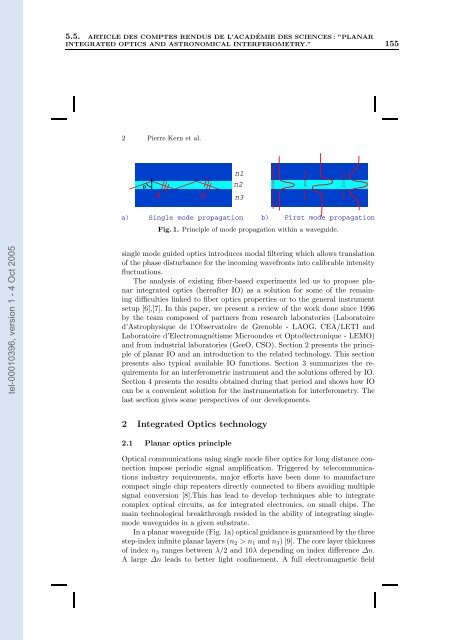Qualification de IONIC, instrument de recombinaison ...
Qualification de IONIC, instrument de recombinaison ...
Qualification de IONIC, instrument de recombinaison ...
You also want an ePaper? Increase the reach of your titles
YUMPU automatically turns print PDFs into web optimized ePapers that Google loves.
tel-00010396, version 1 - 4 Oct 2005<br />
5.5. ARTICLE DES COMPTES RENDUS DE L’ACADÉMIE DES SCIENCES : ”PLANAR<br />
INTEGRATED OPTICS AND ASTRONOMICAL INTERFEROMETRY.” 155<br />
2 Pierre Kern et al.<br />
θ<br />
A B<br />
n1<br />
n2<br />
n3<br />
a) Single mo<strong>de</strong> propagation<br />
Fondamental mo<strong>de</strong><br />
Second mo<strong>de</strong><br />
Third mo<strong>de</strong><br />
b) First mo<strong>de</strong> propagation<br />
Fig. 1. Principle of mo<strong>de</strong> propagation within a wavegui<strong>de</strong>.<br />
single mo<strong>de</strong> gui<strong>de</strong>d optics introduces modal filtering which allows translation<br />
of the phase disturbance for the incoming wavefronts into calibrable intensity<br />
fluctuations.<br />
The analysis of existing fiber-based experiments led us to propose planar<br />
integrated optics (hereafter IO) as a solution for some of the remaining<br />
difficulties linked to fiber optics properties or to the general <strong>instrument</strong><br />
setup [6],[7]. In this paper, we present a review of the work done since 1996<br />
by the team composed of partners from research laboratories (Laboratoire<br />
d’Astrophysique <strong>de</strong> l’Observatoire <strong>de</strong> Grenoble - LAOG, CEA/LETI and<br />
Laboratoire d’Electromagnétisme Microon<strong>de</strong>s et Optoélectronique - LEMO)<br />
and from industrial laboratories (GeeO, CSO). Section 2 presents the principle<br />
of planar IO and an introduction to the related technology. This section<br />
presents also typical available IO functions. Section 3 summarizes the requirements<br />
for an interferometric <strong>instrument</strong> and the solutions offered by IO.<br />
Section 4 presents the results obtained during that period and shows how IO<br />
can be a convenient solution for the <strong>instrument</strong>ation for interferometry. The<br />
last section gives some perspectives of our <strong>de</strong>velopments.<br />
2 Integrated Optics technology<br />
2.1 Planar optics principle<br />
Optical communications using single mo<strong>de</strong> fiber optics for long distance connection<br />
impose periodic signal amplification. Triggered by telecommunications<br />
industry requirements, major efforts have been done to manufacture<br />
compact single chip repeaters directly connected to fibers avoiding multiple<br />
signal conversion [8].This has lead to <strong>de</strong>velop techniques able to integrate<br />
complex optical circuits, as for integrated electronics, on small chips. The<br />
main technological breakthrough resi<strong>de</strong>d in the ability of integrating singlemo<strong>de</strong><br />
wavegui<strong>de</strong>s in a given substrate.<br />
In a planar wavegui<strong>de</strong> (Fig. 1a) optical guidance is guaranteed by the three<br />
step-in<strong>de</strong>x infinite planar layers (n2 > n1 and n3) [9]. The core layer thickness<br />
of in<strong>de</strong>x n3 ranges between λ/2 and 10λ <strong>de</strong>pending on in<strong>de</strong>x difference ∆n.<br />
A large ∆n leads to better light confinement. A full electromagnetic field

















